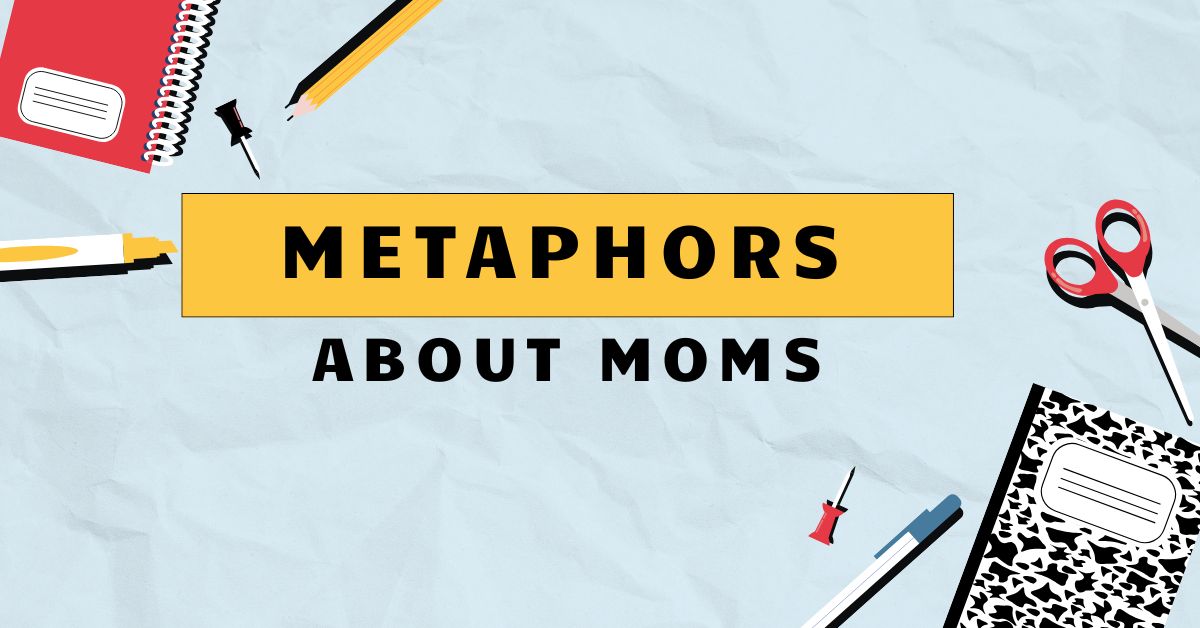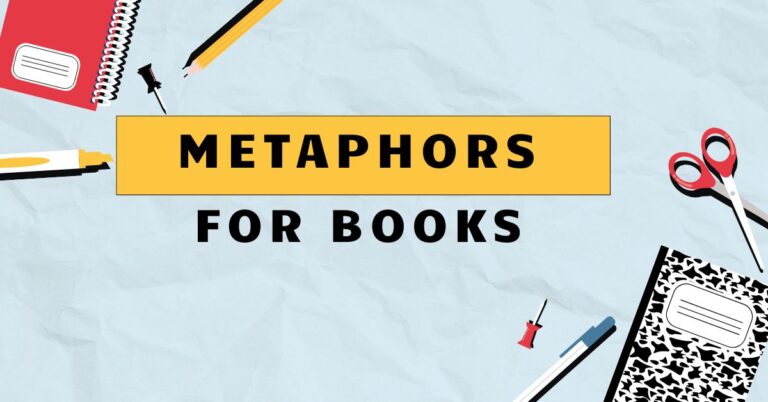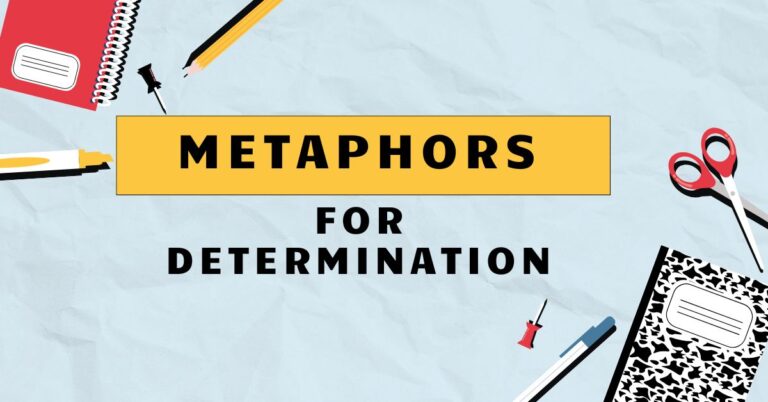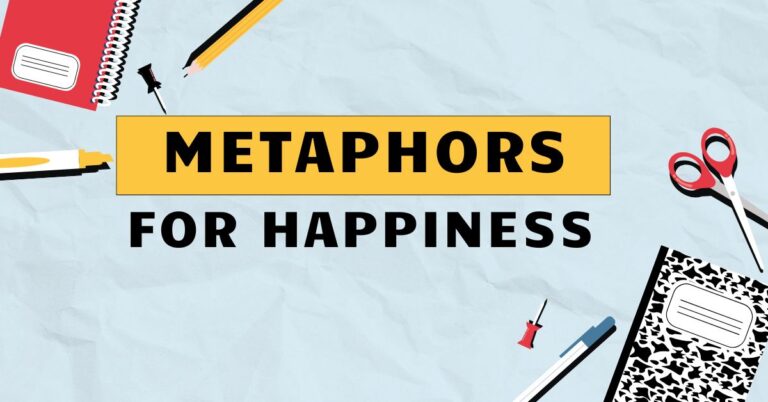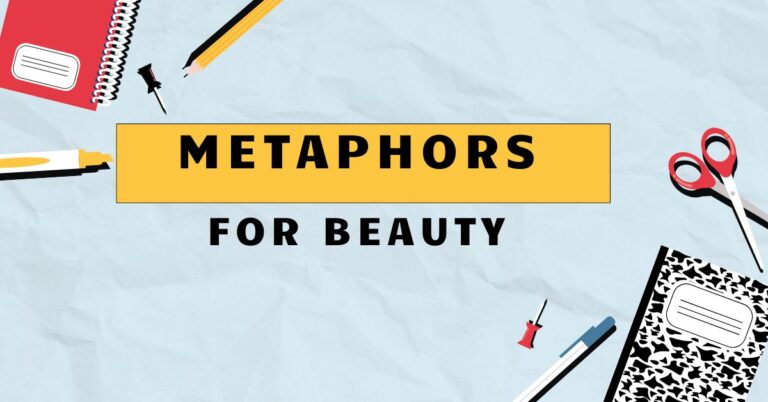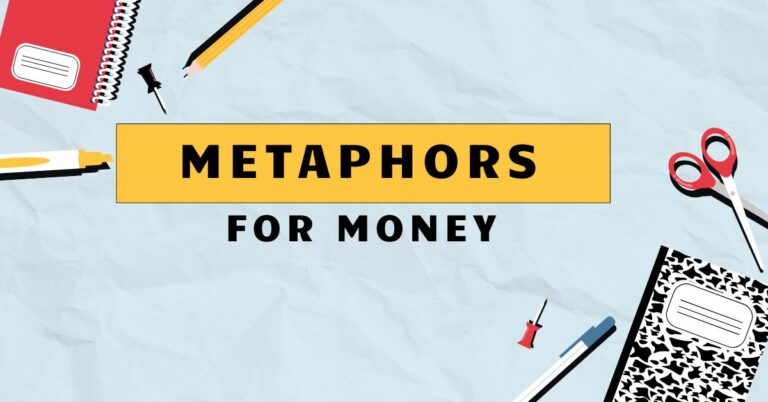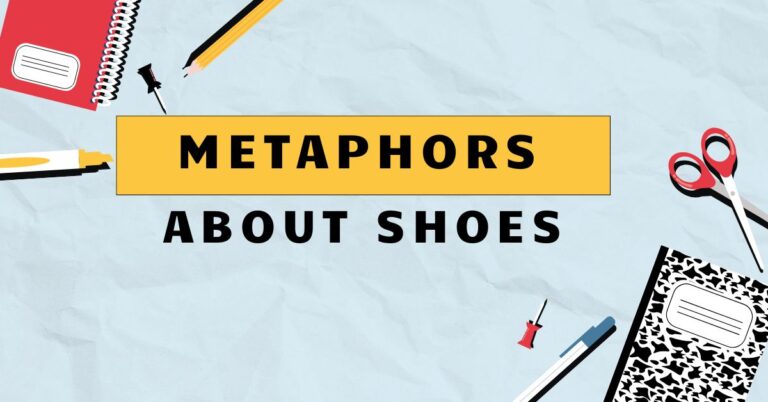31 Metaphors About Moms: Understanding Figurative Language
Metaphors are powerful tools in the English language, allowing us to express complex ideas and emotions in vivid and relatable ways. When we use metaphors to describe mothers, we tap into a rich vein of cultural understanding and personal experience.
Understanding these metaphors not only enhances our comprehension of literature and everyday conversation but also deepens our appreciation for the multifaceted role of mothers. This article provides a comprehensive guide to metaphors about moms, exploring their types, structures, and usages.
This guide will be beneficial for English language learners, students of literature, and anyone interested in the art of figurative language.
Table of Contents
- Definition of Metaphor
- Structural Breakdown of Metaphors
- Types and Categories of Metaphors About Moms
- Examples of Metaphors About Moms
- Usage Rules for Metaphors
- Common Mistakes with Metaphors
- Practice Exercises
- Advanced Topics in Metaphor Usage
- Frequently Asked Questions
- Conclusion
Definition of Metaphor
Ametaphoris a figure of speech that directly compares two unrelated things, asserting that one thingisanother. Unlike similes, which use “like” or “as” to make a comparison, metaphors create a direct and implicit connection.
The purpose of a metaphor is to transfer qualities or characteristics from one concept (the source) to another (the target), thus providing new insights or perspectives. Metaphors are essential for creative writing, poetry, and even everyday communication, adding depth and color to language.
In essence, a metaphor invites the audience to understand something in a new and imaginative way by drawing parallels between seemingly disparate concepts. The effectiveness of a metaphor lies in its ability to evoke strong imagery and resonate emotionally, making abstract ideas more concrete and accessible.
Understanding the nuances of metaphor usage is crucial for both interpreting and creating compelling and meaningful expressions.
Structural Breakdown of Metaphors
Metaphors consist of two primary elements: thetenor(or topic) and thevehicle. The tenor is the subject to which metaphorical attributes are ascribed – in our case, “mom.” The vehicle is the object or concept whose attributes are borrowed to describe the tenor.
For example, in the metaphor “My mom is a rock,” “mom” is the tenor, and “rock” is the vehicle.
The underlying connection between the tenor and the vehicle is known as theground. The ground represents the shared characteristics or qualities that make the comparison meaningful.
In the example above, the ground might be strength, stability, and reliability. Understanding these elements is key to deconstructing and interpreting metaphors effectively.
The interplay between tenor, vehicle, and ground creates a richer and more nuanced understanding of the subject being described. Effective metaphors often rely on implicit grounds, inviting the audience to actively participate in making the connection.
Types and Categories of Metaphors About Moms
Metaphors about moms can be categorized based on the qualities or characteristics they emphasize. Here are some common categories:
Nature Metaphors
Nature metaphors draw parallels between mothers and elements of the natural world. These metaphors often highlight qualities such as growth, resilience, and life-giving properties.
Examples include comparing a mother to a tree, a garden, or a nurturing spring.
Nurturing Metaphors
These metaphors focus on the caring and supportive aspects of motherhood. They often involve images of providing nourishment, comfort, and protection.
Examples include comparing a mother to a warm blanket, a comforting meal, or a safe harbor.
Strength Metaphors
Strength metaphors emphasize the resilience, determination, and unwavering support that mothers provide. These metaphors often involve images of solidity, endurance, and power.
Examples include comparing a mother to a rock, a shield, or a fortress.
Light Metaphors
Light metaphors use imagery of light to describe the guiding, illuminating, and positive influence of a mother. These metaphors often convey hope, clarity, and warmth.
Examples include comparing a mother to a guiding star, a beacon, or a ray of sunshine.
Home and Hearth Metaphors
Home and hearth metaphors emphasize the role of mothers in creating a sense of belonging, comfort, and security. These metaphors often involve images of warmth, shelter, and family.
Examples include comparing a mother to a home, a hearth, or a comforting embrace.
Examples of Metaphors About Moms
Here are some examples of metaphors about moms, organized by category:
Nature Metaphors Examples
The following table provides examples of nature metaphors used to describe mothers. Each example highlights a different aspect of nature and its connection to the qualities of motherhood.
| Metaphor | Explanation |
|---|---|
| My mom is a sturdy oak, weathering every storm. | This metaphor emphasizes the mother’s resilience and strength in the face of adversity. |
| She is the garden where her children bloom. | This highlights the mother’s role in nurturing and fostering growth in her children. |
| Mom is the river that flows through our lives, always providing. | This metaphor conveys the constant support and guidance a mother offers. |
| My mother is the sun, always bringing warmth and light to our family. | This emphasizes her role as a source of positivity and happiness. |
| She’s the mountain that protects us from the harsh winds. | This highlights her protective nature and strength. |
| My mom is the gentle rain that nourishes our souls. | This conveys the subtle but essential nurturing she provides. |
| She’s the forest, full of wisdom and ancient knowledge. | This metaphor implies that the mother holds a great deal of experience and understanding. |
| Mom is the fertile soil where dreams take root. | This emphasizes her role in supporting and encouraging aspirations. |
| She is the vast ocean, full of depth and mystery. | This metaphor suggests that there are many layers to the mother’s personality and experiences. |
| Mom is the blooming flower, radiating beauty and grace. | This emphasizes her beauty and elegance. |
| She is the strong tree, providing shelter and shade. | Highlights her nurturing and protective qualities. |
| My mom is the mountain, steadfast and unmoving. | Emphasizes her stability and strength. |
| She is the gentle breeze, always comforting and calming. | Conveys her soothing and supportive nature. |
| Mom is the roaring fire, full of passion and energy. | Highlights her enthusiasm and vitality. |
| She is the vast sky, full of endless possibilities. | Suggests her boundless love and support. |
| My mom is the deep well, full of wisdom and guidance. | Emphasizes her knowledge and ability to provide direction. |
| She is the fertile earth, nurturing and life-giving. | Conveys her role in fostering growth and development. |
| Mom is the bright star, always shining and guiding. | Highlights her role as a source of inspiration and direction. |
| She is the sturdy branch, supporting and holding strong. | Emphasizes her reliability and strength. |
| My mom is the vibrant meadow, full of life and joy. | Conveys her lively and cheerful nature. |
| She is the quiet stream, peaceful and serene. | Highlights her calming and tranquil presence. |
| Mom is the wild forest, untamed and free. | Emphasizes her independent and adventurous spirit. |
| She is the clear lake, reflective and wise. | Conveys her thoughtful and insightful nature. |
| My mom is the towering cliff, resilient and strong. | Highlights her unwavering strength and endurance. |
Nurturing Metaphors Examples
The following table presents examples of nurturing metaphors, illustrating the caring and supportive aspects of motherhood through various comparisons.
| Metaphor | Explanation |
|---|---|
| My mom is a warm blanket on a cold night. | This emphasizes the comfort and security a mother provides. |
| She is the comforting meal after a long day. | This highlights the nourishment and satisfaction a mother offers. |
| Mom is the safe harbor in a stormy sea. | This conveys the protection and security a mother provides during difficult times. |
| She’s the gentle hand that guides us through life. | This emphasizes her role in providing guidance and support. |
| My mother is the soothing balm that heals all wounds. | This highlights her ability to comfort and heal emotional pain. |
| She is the lullaby that calms our fears. | This conveys the peace and tranquility a mother brings. |
| Mom is the gentle rain that nourishes our souls. | This emphasizes the subtle but essential nurturing she provides. |
| She’s the band-aid on every scraped knee. | This highlights her ability to quickly and effectively address problems. |
| My mom is the soft pillow where we rest our weary heads. | This conveys the comfort and relaxation a mother provides. |
| She is the warm fire that keeps us safe from the cold. | Highlights her protective and comforting presence. |
| My mom is the gentle breeze that cools our fevered brows. | Emphasizes her soothing and caring nature. |
| She is the comforting embrace that melts away our worries. | Conveys the sense of security and love she provides. |
| Mom is the nourishing soup that warms us from the inside out. | Highlights her ability to provide comfort and sustenance. |
| She is the gentle hand that wipes away our tears. | Emphasizes her empathy and caring nature. |
| My mom is the soft lullaby that lulls us to sleep. | Conveys the sense of peace and tranquility she brings. |
| She is the warm sunshine that chases away the blues. | Highlights her ability to bring happiness and positivity. |
| Mom is the gentle rain that washes away our troubles. | Emphasizes her ability to cleanse and renew. |
| She is the comforting presence that makes everything alright. | Conveys the sense of security and reassurance she provides. |
| My mom is the warm hug that makes us feel loved. | Highlights her affection and nurturing nature. |
| She is the gentle touch that heals our wounds. | Emphasizes her caring and healing abilities. |
| Mom is the steady hand that guides us through the darkness. | Highlights her role in providing guidance and support. |
| She is the soothing voice that calms our fears. | Conveys the sense of peace and reassurance she brings. |
| My mom is the gentle shower that cleanses us from the day’s grime. | Emphasizes her ability to refresh and renew. |
| She is the warm smile that brightens our day. | Highlights her positivity and ability to uplift. |
Strength Metaphors Examples
The following table showcases strength metaphors used to describe mothers, highlighting their resilience, determination, and unwavering support.
| Metaphor | Explanation |
|---|---|
| My mom is a rock, always solid and dependable. | This emphasizes her stability and unwavering support. |
| She is a shield, protecting us from harm. | This highlights her protective nature and strength. |
| Mom is a fortress, strong and impenetrable. | This conveys her ability to withstand challenges and protect her family. |
| She’s the anchor that keeps us grounded. | This emphasizes her role in providing stability and security. |
| My mother is the steel backbone of our family. | This highlights her strength and resilience. |
| She is the unwavering pillar that supports our dreams. | This conveys her constant support and encouragement. |
| Mom is the sturdy bridge that connects us all. | This emphasizes her role in uniting and supporting her family. |
| She’s the iron will that never gives up. | This highlights her determination and perseverance. |
| My mom is the unyielding oak that stands tall against the storm. | This conveys her strength and resilience in the face of adversity. |
| She is the resilient spirit that overcomes all obstacles. | Highlights her determination and ability to persevere. |
| My mom is the unwavering light that guides us through darkness. | Emphasizes her role as a source of hope and direction. |
| She is the strong foundation upon which our lives are built. | Conveys her importance and stability in our lives. |
| Mom is the iron gate that protects us from danger. | Highlights her protective and unwavering strength. |
| She is the unshakeable tree that weathers every storm. | Emphasizes her resilience and ability to endure. |
| My mom is the steadfast mountain that stands tall and proud. | Conveys her strength and unwavering presence. |
| She is the unbreakable bond that holds our family together. | Highlights her role in uniting and supporting her family. |
| Mom is the unwavering flame that burns brightly through the night. | Emphasizes her determination and passion. |
| She is the solid ground upon which we stand. | Conveys her stability and unwavering support. |
| My mom is the unbreakable wall that shields us from harm. | Highlights her protective and resilient nature. |
| She is the unyielding force that drives us forward. | Emphasizes her determination and ability to inspire. |
| Mom is the resilient vine that grows stronger with each challenge. | Highlights her ability to adapt and overcome obstacles. |
| She is the unwavering spirit that never loses hope. | Conveys her optimism and unwavering belief in us. |
| My mom is the mighty river, carving paths through the toughest terrain. | Emphasizes her strength and determination in overcoming obstacles. |
| She is the sturdy trunk that supports the branches of our family. | Highlights her role in providing stability and support. |
Light Metaphors Examples
The following table provides examples of light metaphors used to describe mothers, emphasizing their guiding, illuminating, and positive influence.
| Metaphor | Explanation |
|---|---|
| My mom is a guiding star, always showing us the way. | This emphasizes her role as a source of direction and inspiration. |
| She is a beacon, illuminating the path ahead. | This highlights her ability to provide clarity and guidance. |
| Mom is a ray of sunshine, bringing warmth and joy to our lives. | This conveys her positivity and ability to uplift. |
| She’s the light at the end of the tunnel. | This emphasizes her role in providing hope and encouragement. |
| My mother is the radiant glow that brightens our days. | This highlights her positive influence and energy. |
| She is the sparkling gem that shines in our lives. | This conveys her value and importance. |
| Mom is the bright flame that warms our hearts. | This emphasizes her ability to bring comfort and joy. |
| She’s the sunbeam that chases away the shadows. | This highlights her ability to bring positivity and dispel negativity. |
| My mom is the illuminating candle that guides us through darkness. | This conveys her ability to provide direction and clarity. |
| She is the sparkling diamond that shines with brilliance. | Highlights her value and radiance. |
| My mom is the radiant moon that illuminates our nights. | Emphasizes her gentle and supportive presence. |
| She is the glowing ember that warms our souls. | Conveys her comforting and nurturing nature. |
| Mom is the bright spark that ignites our passions. | Highlights her ability to inspire and motivate. |
| She is the shining star that guides us home. | Emphasizes her role as a source of direction and security. |
| My mom is the radiant sun that nourishes our spirits. | Conveys her life-giving and supportive nature. |
| She is the brilliant lantern that lights our way. | Highlights her ability to provide clarity and guidance. |
| Mom is the shimmering aurora that captivates our hearts. | Emphasizes her beauty and magical presence. |
| She is the bright firefly that twinkles in the night. | Conveys her gentle and enchanting nature. |
| My mom is the illuminating ray that pierces through the clouds. | Highlights her ability to bring hope and positivity. |
| She is the radiant dawn that welcomes each new day. | Emphasizes her optimism and ability to bring new beginnings. |
| Mom is the glowing hearth that warms our home. | Highlights her role in creating a sense of comfort and security. |
| She is the sparkling light that dances in our eyes. | Conveys her joy and positive influence. |
| My mom is the guiding flashlight that helps us find our way. | Emphasizes her practicality and ability to provide direction. |
| She is the radiant smile that brightens our world. | Highlights her positivity and ability to uplift. |
Home and Hearth Metaphors Examples
The following table showcases home and hearth metaphors used to describe mothers, emphasizing their role in creating a sense of belonging, comfort, and security.
| Metaphor | Explanation |
|---|---|
| My mom is a home, a place of comfort and belonging. | This emphasizes her role in creating a sense of security and love. |
| She is the hearth, the warm center of our family. | This highlights her ability to provide warmth and connection. |
| Mom is a comforting embrace, a safe haven from the world. | This conveys the sense of security and love she provides. |
| She’s the foundation upon which our family is built. | This emphasizes her importance and stability. |
| My mother is the heart of our home, always beating with love. | This highlights her central role and loving nature. |
| She is the warm kitchen where memories are made. | This conveys the sense of comfort and connection she creates. |
| Mom is the cozy blanket that wraps us in love. | This emphasizes her comforting and nurturing nature. |
| She’s the safe harbor where we can always return. | This highlights her role in providing security and comfort. |
| My mom is the welcoming door that is always open. | This conveys her openness and willingness to provide support. |
| She is the warm fire that keeps us safe from the cold. | Highlights her protective and comforting presence. |
| My mom is the quiet corner where we find peace. | Emphasizes her ability to provide tranquility and comfort. |
| She is the comforting aroma that fills our home with warmth. | Conveys the sense of security and love she provides. |
| Mom is the safe room where we can always be ourselves. | Highlights her acceptance and support. |
| She is the familiar melody that soothes our souls. | Emphasizes her comforting and calming nature. |
| My mom is the cherished memory that we hold dear. | Conveys her importance and lasting impact. |
| She is the strong roof that protects us from the storm. | Highlights her protective and resilient nature. |
| Mom is the familiar scent that welcomes us home. | Emphasizes her comforting and familiar presence. |
| She is the warm embrace that melts away our worries. | Conveys the sense of security and love she provides. |
| My mom is the cozy nook where we feel safe and loved. | Highlights her ability to create a sense of comfort and security. |
| She is the sturdy walls that stand strong against the world. | Emphasizes her resilience and protective nature. |
| Mom is the comforting quilt that wraps us in warmth. | Highlights her nurturing and caring presence. |
| She is the safe haven where we can always be ourselves. | Conveys her acceptance and support. |
| My mom is the gentle lullaby that lulls us to sleep. | Emphasizes her calming and comforting nature. |
| She is the cherished tradition that binds us together. | Highlights her role in creating family bonds and memories. |
Usage Rules for Metaphors
Using metaphors effectively requires careful consideration of context and audience. Here are some key rules to follow:
- Clarity: Ensure that the connection between the tenor and the vehicle is clear. The metaphor should enhance understanding, not confuse the audience.
- Relevance: Choose vehicles that have relevant and meaningful associations with the tenor. The shared qualities should be apparent and significant.
- Originality: Strive for fresh and original metaphors. Overused metaphors can become clichés and lose their impact.
- Consistency: Maintain consistency within the metaphor. Avoid mixing metaphors that create conflicting or nonsensical images.
- Appropriateness: Consider the tone and context of the communication. Metaphors should be appropriate for the audience and purpose.
Furthermore, it’s important to avoid mixed metaphors, where the combination of two or more metaphors creates an incongruous image. For instance, saying “She’s the rock that will help you navigate the stormy seas” mixes the metaphor of a rock (stability) with navigating a sea (requiring movement), resulting in a confusing image.
Common Mistakes with Metaphors
Here are some common mistakes to avoid when using metaphors:
| Incorrect | Correct | Explanation |
|---|---|---|
| My mom is like a rock. | My mom is a rock. | The first example is a simile, not a metaphor. Metaphors make a direct comparison without using “like” or “as.” |
| She is a rock and a guiding star. | She is a guiding star, always showing us the way. OR She is a rock, always solid and dependable. |
This mixes metaphors that don’t logically connect. It’s better to stick to one metaphor or use them separately. |
| My mom is a rock, but she’s also very flexible. | My mom is a rock, always solid and dependable, even in changing times. | This creates a contradictory image. The metaphor should align with the intended qualities. |
| She is a bright light in the dark and a warm blanket. | She is a bright light in the dark, guiding us through difficult times. OR She is a warm blanket, providing comfort and security. |
This mixes metaphors that don’t logically connect. It’s better to stick to one metaphor or use them separately. |
Practice Exercises
Test your understanding of metaphors with these exercises:
-
Identify the metaphor in the following sentence: “My mom is the glue that holds our family together.”
-
What qualities are being emphasized in the metaphor: “She is the garden where her children bloom?”
-
Rewrite the following simile as a metaphor: “My mom is like a shield, protecting us from harm.”
-
Create a metaphor about a mom using the image of a lighthouse.
-
Identify the tenor and vehicle in the metaphor: “My mom is the sun, always bringing warmth and light to our family.”
-
Correct the mixed metaphor: “She’s the rock that flies high in the sky.”
-
What category does the following metaphor belong to: “My mom is a sturdy oak, weathering every storm?”
-
Explain the ground in the metaphor: “Mom is the safe harbor in a stormy sea.”
-
Create a metaphor about a mom using the image of a book.
-
Replace the underlined word with a metaphor: “My mom is a strong person.”
Answers
- The metaphor is “My mom is the glue.”
- The qualities being emphasized are nurturing, growth, and care.
- My mom is a shield, protecting us from harm.
- My mom is a lighthouse, guiding us safely through life’s storms.
- Tenor: Mom; Vehicle: Sun.
- She is a rock, providing unwavering stability.
- Nature Metaphor.
- The ground is safety, protection, and security during difficult times.
- My mom is a book, full of wisdom and stories.
- My mom is a fortress.
Advanced Topics in Metaphor Usage
For advanced learners, consider exploring these more complex aspects of metaphor usage:
- Extended Metaphors: A metaphor that is sustained over several lines or throughout an entire work.
- Dead Metaphors: Metaphors that have become so common that they are no longer recognized as figurative language (e.g., “the leg of a table”).
- Conceptual Metaphors: Underlying cognitive structures that shape our understanding of abstract concepts (e.g., “argument is war”).
- The role of metaphor in cognitive linguistics: How metaphors influence thought and perception.
Understanding these advanced topics can deepen your appreciation for the pervasive influence of metaphors in language and thought. Exploring conceptual metaphors, for example, can reveal how deeply ingrained certain metaphorical frameworks are in our understanding of the world.
Analyzing extended metaphors in literature can provide insight into the author’s thematic intentions and stylistic choices. Recognizing dead metaphors can help you become more aware of the evolution and dynamism of language.
Frequently Asked Questions
- What is the difference between a metaphor and a simile?
A metaphor directly compares two unlike things, stating that one thing is another. A simile, on the other hand, uses “like” or “as” to make a comparison. For example, “My mom is a rock” (metaphor) vs. “My mom is like a rock” (simile).
- Why are metaphors important in language?
Metaphors add depth, color, and creativity to language. They allow us to express complex ideas in vivid and relatable ways, enhancing communication and understanding. They also tap into emotional and cultural associations, making language more resonant and meaningful.
- How can I improve my ability to use metaphors effectively?
Read widely and pay attention to how metaphors are used in literature and everyday conversation. Practice creating your own metaphors, focusing on clarity, relevance, and originality. Seek feedback from others to refine your usage.
- What is a mixed metaphor, and why should I avoid it?
A mixed metaphor combines two or more metaphors that create an incongruous or nonsensical image. It can confuse the audience and undermine the effectiveness of your communication. For example, “Let’s nip it in the bud and then put it on the back burner” is a mixed metaphor that combines gardening and cooking imagery in a confusing way.
- Are some metaphors better than others?
Yes, effective metaphors are clear, relevant, original, and appropriate for the context and audience. Overused or cliché metaphors can lose their impact, while confusing or irrelevant metaphors can hinder understanding. The best metaphors are those that provide fresh insights and resonate emotionally.
- How do cultural differences affect the interpretation of metaphors?
Metaphors are often rooted in cultural experiences and associations. A metaphor that is meaningful in one culture may not resonate in another. Understanding these cultural nuances is crucial for effective cross-cultural communication.
- Can metaphors be used in formal writing?
Yes, metaphors can be used in formal writing, but they should be used judiciously. Ensure that the metaphors are appropriate for the tone and purpose of the writing, and avoid overusing them. In academic writing, metaphors can be effective for explaining complex concepts, but they should be used with precision and clarity.
- What is the role of context in understanding metaphors?
Context is crucial for understanding metaphors because it provides the necessary background information to interpret the comparison being made. The surrounding sentences, the overall tone of the text, and the cultural background can all influence how a metaphor is understood.
- How can I identify a metaphor in a text?
Look for statements that assert that one thing is another, without using “like” or “as.” Consider whether the statement is literally true. If not, it is likely a metaphor. Pay attention to the qualities being transferred from one concept to another.
- Are there any specific types of metaphors that are particularly effective for describing mothers?
While effectiveness depends on the specific context and desired effect, metaphors that emphasize nurturing, strength, and guidance often resonate well when describing mothers. Examples include comparing a
mother to a garden, a rock, or a guiding star.
Conclusion
Metaphors are a powerful and versatile tool for describing the multifaceted role of mothers. By understanding the structure, types, and usage rules of metaphors, we can appreciate the depth and richness they bring to language.
Whether through nature metaphors, nurturing metaphors, strength metaphors, light metaphors, or home and hearth metaphors, these figures of speech allow us to convey the profound impact and enduring qualities of mothers in our lives. By avoiding common mistakes and practicing effective usage, we can harness the full potential of metaphors to express our admiration, love, and gratitude for moms.
As you continue to explore and experiment with metaphors, remember that the key to effective usage lies in clarity, relevance, and originality. Strive to create metaphors that not only convey meaning but also evoke emotion and resonate with your audience.
By doing so, you can elevate your communication and deepen your appreciation for the art of figurative language.

